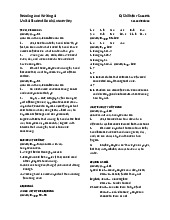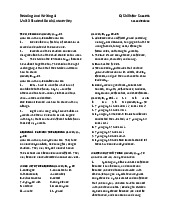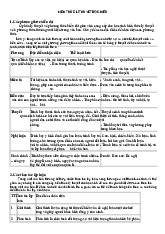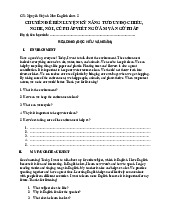





Preview text:
lOMoAR cPSD| 36066900 lOMoAR cPSD| 36066900 UNIT 1 _ SHORT ANSWERS
Practice 1. The Peace Corps
On March 1, 1961, President John F. Kennedy issued an order creating the Peace Corps.
Its mission was to promote world peace and friendship by providing qualified volunteers to
interested countries. Today it sends an average of 6,000 U.S. citizens abroad each year.
Volunteers live at a local level in their host countries. They are paid in local currency.
Each month they receive a small sum of money that covers basic living expenses and varies
with the local economy. For example, volunteers in Micronesia make the equivalent of $300
per month, while those in Turkmenistan make $75. Most volunteers live with host families.
This is a great chance to learn the language and the culture.
For each month that they spend overseas, volunteers receive a sum of about $200. This
money helps them to get back on their feet in the United States.
Serving countries all over the world, the Peace Corps lives up to its promise as “the
toughest job you’ll ever love.” Volunteers do everything from teaching English to sharing
tips on growing food to providing preventive health care. However, the application process
to become a Peace Corps volunteer is very competitive. You must be a U.S. citizen, at least
eighteen years old, in good health, and willing to serve for two years. Nearly all volunteers
have a bachelor’s degree in their chosen field, and about 18 percent have their master s or
doctorate degrees. Knowing a language, especially French and Spanish, helps.
Read the passage The Peace Corps and answer the following questions with NO MORE
THAN THREE WORDS taken from the passage.
1. What kind of U.S. citizens does the Peace Corps send abroad to fulfil its mission? qualified volunteers
2. What does the monthly payment in local currency to volunteers cover?basic living expenses
3. Whom do the volunteers stay with in their host countries? host families.
4. What is the shortest time that volunteers can work for the Peace Corps?two years lOMoAR cPSD| 36066900
5. Which languages are given as an example of what can benefit volunteers? French and Spanish
Practice 2. Out of the Wild, into Our Homes
Many of the earth’s creatures die because of choices humans make. These choices have
nothing to do with food or shelter or anything else that helps humans survive. What kills these
millions of animals from all over the world is human greed - the desire for money.
People use parts of animals for everything from hats to handbags, from ornamental jewelry
and ashtrays to powders that supposedly improve a person’s life. Declaring a species
endangered and protecting it by laws is not always enough. Poachers, people who kill wildlife illegally, rarely get caught.
During the late 1980s, saving elephants became a popular cause. Wildlife protection groups
made sure everyone saw pictures or films of elephants with their faces sawed off for their ivory
tusks. These groups also proved that certain populations of elephants were dwindling.
As a result, most people stopped buying objects made of ivory. Laws against poaching were
strengthened. Many countries made bringing ivory in from other countries illegal. Killing
elephants for their ivory became more risky and less profitable.
However, concern for a certain species tends to fade after a while. In the late 1970s, people
protested against the slaughter of seal pups. Everyone was shocked at the sight of pups being
clubbed to death in their icy habitat. The brutality came to a halt. But ten years later, the
number of seal pups killed was higher than ever.
Other animal protection movements have come and gone, such as saving the whales and
protecting dolphins from the tuna fishermen. The whale population appears to have increased
for now. And the laws are finally changing in the United States to protect the dolphins that
swim with tuna fish in parts of the Pacific Ocean.
In the 2010s, the protests and the publicity will probably turn to some other endangered
species. Plenty of them urgently need attention. During this time, will the elephants be lOMoAR cPSD| 36066900 forgotten? 1
Word Use _ Decide which of the following choices is closest in meaning to the underlined
word in the sentence and write down the corresponding letter.
1. Declaring a species endangered and protecting it by laws is not always
enough. A. in danger B. out of danger C. causing danger 2.
These groups also proved that certain populations of elephants were
dwindling. A. becoming more B. becoming smaller C. becoming weaker
3. However, concern for a certain species tends to fade after a while.
A. strengthen B. disappear C. change
4. Everyone was shocked at the sight of pups being clubbed to death in their icy
habitat. A. shot B. kicked C. beaten
Short-Answer Questions _Read the passage Out of the Wild, into Our Homes and answer the
following questions with NO MORE THAN THREE WORDS taken from the passage.
5. According to the passage, what do people use to make things that people think can improve their lives? parts of animals
6. What do people kill elephants and cut their faces off for? ivory tusks
7. What animal is mentioned after elephants as a victim of humans?seal pups
8. Whom do some animal protection movements want to protect dolphins from?the tuna fishermen
Practice 3. More Cavities Needed
Bluebirds live in cavities, but they can’t make their own cavities. Like woodpeckers, bluebirds
prefer trees in open areas. The best habitat for bluebirds is an open area with scattered trees
such as an old garden. By clearing sections of forest to create more fields, early settlers
happened to improve bluebird habitat. Bluebirds feed on insects on the ground, and insects were abundant in the fields.
In the early 1900s, eastern bluebirds were one of the most common songbirds, but by 1969
fewer than 100 bluebirds nested in Minnesota. Other states also reported severe declines in the lOMoAR cPSD| 36066900
populations of all three bluebird species.
Why did the populations decline? One factor may have been the widespread use of insecticides,
but the most important factor was probably the loss of habitat. At first, fences were built with
wooden posts, and wooden posts develop cavities. While bluebirds like fence posts with
cavities, farmers do not. Cavities make the fence posts weak, and cattle escape through weak
fences. After World War II, most farmers replaced wooden posts with new posts made of steel.
With less suitable habitat, the bluebirds were forced to compete with other birds for the few
remaining nesting sites. More aggressive birds such as the tree swallow and the house wren
often drive the bluebirds from their nests. Starlings and house sparrows - both introduced to
this country from Europe - also compete with the bluebirds for nesting sites.
All three bluebird populations - eastern, western, and mountain - declined nearly 90 percent
between 1935 and 1985. The North American Bluebird Society and others are working to
increase the number of bluebirds. The most successful method is to improve the habitat by
providing the bluebirds with boxes as living places. Thousands of boxes are placed and being
managed by individuals interested in helping the little bird.
If placed in the right environment, the boxes do attract bluebirds. Bluebirds prefer boxes placed
next to open areas. If placed near a brushy area, the boxes are more likely to attract house
wrens. Tree swallows would compete for isolated sites in open areas. Competition from tree
swallows will decrease if the boxes are placed in pairs, less than three feet apart. Boxes for
mountain and western bluebirds must have slightly larger holes than those for eastern
bluebirds, but if the holes are too large, starlings will take the boxes.
Another cavity programme helped the wood duck population. When seeking for houses, the
female wood duck looks for a cavity in a tree that is in or near the water. Often she chooses a
cavity with a hole too small for a raccoon to enter. Human activities - logging mature trees and
hunting — threaten the wood duck population. In 1918, the United States and Canadian
governments banned the hunting of this species. Groups of citizens and conservation
organisations built living boxes and placed them on poles or in trees that are in or near the
water. Today the wood duck population is greater than one million, and hunting is once again permitted. lOMoAR cPSD| 36066900
Word Use _ Decide which of the following choices is closest in meaning to the underlined
word in the sentence and write down the corresponding letter.
1. The best habitat for bluebirds is an open area with scattered trees such as an old garden. A. closely planted B. carefully trimmed C. widely separated
2. Why did the populations decline? One factor may have been the widespread use of insecticides.
A. chemical substances made to kill insects
B. chemical substances made to help insects
C. chemical substances made to strengthen insects
3. More aggressive birds such as the tree swallow and the house wren often drive the bluebirds from their nests. A. always ready to escape B. always ready to sing C. always ready to attack
4. Boxes for mountain and western bluebirds must have slightly larger holes than those for
eastern bluebirds, but if the holes are too large, starlings will take the
boxes. A. a few B. a bit C. a lot
5. In 1918, the United States and Canadian governments banned the hunting of this
species. A. controlled B. forbade C. encouraged Short-Answer Questions
Refer to the passage More Cavities Needed and answer the following questions with NO
MORE THAN THREE WORDS taken from the passage.
6. What place is given as an example of the best habitat for bluebirds?old garden
7. According to the passage, who accidentally helped with improving bluebird habitat? early settlers
8. How many species do bluebirds have? three
9. What is the most important reason for the severe decline in the population of bluebirds?loss of habitat
10. Which material do most farmers prefer when they made fences? steel lOMoAR cPSD| 36066900
11. Among the bluebirds species, which one prefers boxes with smaller holes than the
other bluebirds do? eastern bluebirds Question: 1.Who helps the boy? -> The man 2.What is on fire? -> The house 3. Where is the man walking? -> a street
4. What does the man do first? -> He calls the police
5. Why does the man go inside the house?
->Someone inside the house yelling for help
6.What does the man see inside the house? ->A little boy 7.When do the police arrive?
->After the boy is out of the house



